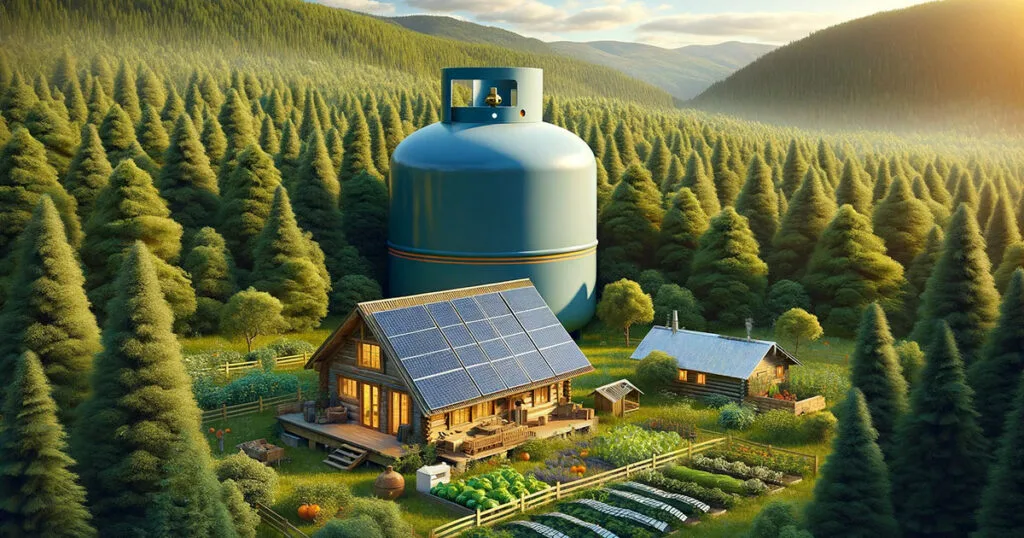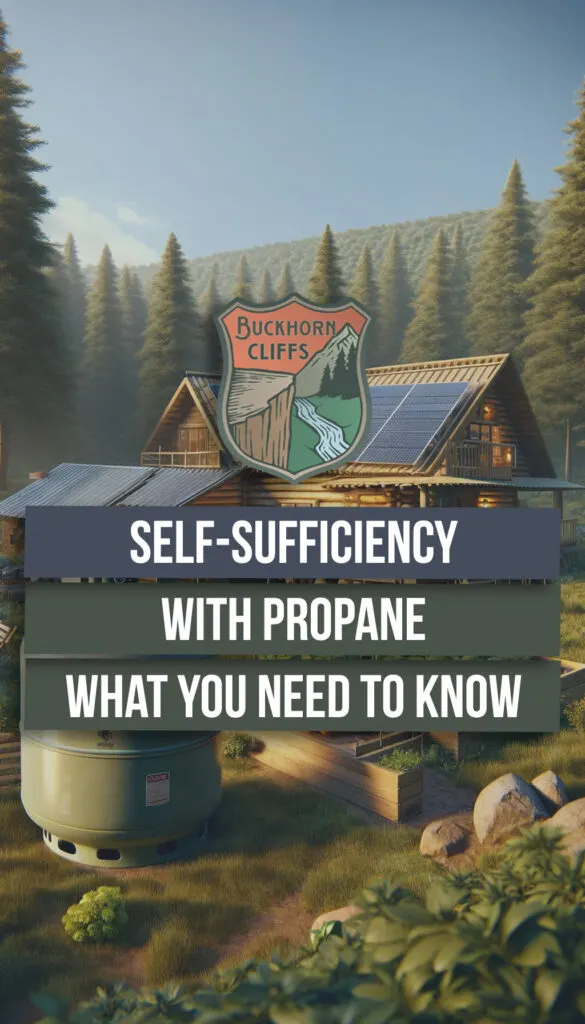If you’re equipped with the necessary tools and have ready access to timber, wood emerges as an optimal choice. In a scenario where societal structures collapse, the continuous supply of propane would likely be disrupted, rendering wood a reliable alternative for the long haul. However, for immediate needs and possibly extending into a few years under survival conditions, propane presents a more practical solution. The ease of use and availability of tools designed for propane make it a superior option during the initial stages of a survival scenario.
- Where/How to Store Propane
- Considerations and Fears of Propane
- Tank Sizes and Comparison
- How Much Propane Should I Keep?
- Propane for Survival: Methods, Tools

Storing propane safely and effectively involves understanding best practices, addressing common concerns, and knowing the different tank sizes available. Let’s break down each aspect to ensure you have all the information you need.
- Check out this post: Propane Tools for Emergency Scenarios
- View all Propane product suggestions
Wood vs. Propane
One interesting consideration with wood vs. propane (this is coming from someone who love both fuel sources).
When choosing between a cord of wood and 1,000 gallons of propane for heating:
- Space Needed: Both take up about the same space, but propane contains more energy, meaning it heats longer from the same amount of storage space.
- How Long They Last: A cord of wood might last around a month of continuous use, while 1,000 gallons of propane could theoretically heat for over two years. This calculation assumes you’re using a set amount of heat each day, with propane being much more efficient and lasting far longer under the same conditions.
Calculations for the Propane: With 1,000 gallons of propane and assuming a furnace efficiency of 90%, you’d have an effective 82,350,000 BTUs available. If your daily consumption rate for heating a well-insulated 1,000 sq ft cabin is around 100,000 BTUs (a rough estimate for continuous heating under cold conditions), this amount of propane could theoretically last for approximately 823.5 days.
In simple terms, propane offers a more efficient, longer-lasting heating solution that’s easier to manage, making it a practical choice for those looking for convenience and extended use.
Where/How to Store Propane
Proper Location: I store smaller propane tanks in my barn or garage. However, many suggest storing propane tanks outside, in a well-ventilated area. If you’re not comfortable storing your portable propane tanks in your garage, create a simple structure to keep your tanks out of the elements.
If you’ve taken steps to ensure your garage is ventilated and you’re diligent about conducting regular smell tests for detecting propane leaks, it can mitigate risks associated with storing propane tanks in a garage.
Propane Tank Garage Storage
- Enhance Ventilation: Ensure your garage has adequate ventilation. This might involve installing additional vents or fans to facilitate air flow. This could even mean you regularly open your garage door.
- Regular Smell Tests: Being proactive about conducting smell tests can help in early detection of leaks. Since propane has a strong odorant added to it, any leaks should be noticeable through the smell of rotten eggs or sulfur. If you detect this odor, it’s crucial to act quickly to address the leak.
- Leak Detection Practices: Apart from relying on smell, consider using a gas leak detector as an additional safety measure. These devices can provide an early warning before gas levels reach a dangerous concentration.
- Safe Storage Practices: Store propane tanks upright and ensure they are secured to prevent them from tipping over.
- Regular Inspections: Inspect your propane tanks and connections regularly for signs of wear, rust, or damage. Ensure that all parts of the propane system are in good working order.
Orientation: Cylinders should be stored upright on a stable, flat surface to prevent leaks from the relief valve, which is designed to release pressure if it becomes too high.
Protection from Elements: While propane tanks are generally designed for outdoor use, protecting them from extreme temperatures, direct sunlight, and moisture can help prevent rust and extend their lifespan.
Considerations and Fears of Propane
Leakage and Explosions: The primary fear is the risk of propane leaks leading to fires or explosions. Regularly check for leaks using a soap and water solution on connections and smelling for propane, which has an added odorant that smells like rotten eggs.
Propane tanks are engineered with multiple safety features to prevent explosions, but under certain critical conditions, explosion risks can arise (but it’s very unlikely):
- Pressure Build-up: Tanks incorporate pressure relief valves to vent propane if internal pressure exceeds safe limits. Failure or obstruction of these valves can lead to dangerous pressure build-up and potential tank rupture.
- BLEVE (Boiling Liquid Expanding Vapor Explosion): Exposure to extreme heat can cause the liquid propane inside a tank to boil, drastically increasing pressure. If the tank’s structural integrity is compromised or the pressure exceeds the relief valve’s capacity, a BLEVE can occur, characterized by the explosive rupture of the tank.
- External Fire or Heat: Direct exposure to fire or excessive heat can escalate internal pressure rapidly. If the tank’s pressure relief mechanisms fail under such conditions, the risk of explosion increases, especially in confined spaces where gases can’t disperse.
- Structural Damage: Impact, corrosion, or improper handling can weaken the tank’s structure. Pressurization or heat exposure of a compromised tank heightens the likelihood of failure.
Proper Handling: Incorrect handling can cause valve damage or leaks. It’s essential to transport and store cylinders upright and secure them to prevent falling over.
Tank Sizes and Comparison
Propane tanks come in various sizes, ranging from small portable cylinders to large stationary tanks, measured in pounds or gallons.
Portable Cylinders: Common sizes include 20-pound cylinders, often used for BBQ grills and small heating devices, and 30- to 40-pound cylinders for RVs and camping. These are convenient for their mobility but require more frequent refilling.
Residential Tanks: Sizes range from 100 gallons (used for cooking or hot water) to 500 or 1,000 gallons for whole-house heating. The choice depends on usage, climate, and the size of the house.
Commercial and Agricultural Use: Larger tanks exceeding 1,000 gallons are used for commercial, agricultural, or emergency backup purposes, providing a substantial fuel supply but requiring professional installation and maintenance.
How Much Propane Should I Keep?
When deciding how much propane to store, the guiding principle should be to stock as much as your storage space safely allows. Propane has an indefinite shelf life, meaning it doesn’t degrade over time, which makes it an ideal fuel source for long-term storage. The amount you choose to keep on hand should reflect your anticipated needs for cooking and heating, considering both daily use and potential emergency situations.
- Safety and Storage Space: First, assess your available storage space. Propane tanks should be stored in an area that’s ventilated to some degree. Your capacity to store propane safely will largely dictate how much you can keep.
- Usage Needs: Estimate your propane consumption based on your routine needs for cooking and heating. Consider the efficiency of your appliances and the climate in your area, as colder climates may necessitate higher usage for heating.
- Emergency Preparedness: In emergency situations, such as natural disasters or societal disruptions, access to propane can become limited. Storing a sufficient supply can ensure you have the means to cook food and heat your living area when other fuel sources might not be available. A good rule of thumb is to have enough propane to last at least several weeks to a few months, depending on your storage capabilities and usage rates.
- Tools and Appliances: Ensure you have the appropriate tools and appliances that can operate efficiently on propane. Investing in propane-compatible cooking appliances and heaters can maximize the utility of your stored fuel.
- Regular Maintenance: Regularly inspect your propane tanks and connections for leaks or damage. Keeping your propane storage and appliances in good working order is essential for safety and efficiency.
Propane for Survival: Methods, Tools, and Key Considerations
Propane stands out as a versatile and reliable fuel source for survival situations, offering benefits for both immediate needs and long-term planning. Understanding how to integrate propane into your survival strategy involves exploring methods of use, essential tools, and important safety and storage considerations. Here’s an overview to guide you through harnessing propane’s full potential in your survival preparations.
Propane Usage Methods
- Heating: Propane heaters can provide warmth in cold conditions, making them indispensable in winter survival scenarios. Portable propane heaters are suitable for indoor use, provided they are designed for safe indoor operation.
- Cooking: Propane stoves offer a dependable way to cook food when traditional energy sources are unavailable. From single burners for individual use to larger camp stoves for family needs, propane cooking solutions are diverse.
- Lighting: Propane lanterns can illuminate your surroundings, essential for nighttime safety and comfort when electricity is not an option.
- Refrigeration: Propane-powered refrigerators are critical for long-term food storage, especially in off-grid situations or prolonged emergencies.
- VIEW ALL PRODUCT RECOMMENDATIONS
Essential Tools for Propane Use
- Propane Tanks: Adequate storage capacity is important. Opt for multiple sizes to suit different needs, from portable cylinders for light cooking and heating to larger tanks for sustained energy supply.
- Regulators and Hoses: Ensure you have the right connectors, regulators, and hoses compatible with your propane appliances. Regular inspection and maintenance are key to safety.
- Leak Detection Solutions: Equip yourself with soap water solution or a commercial leak detector spray to routinely check for leaks in connections.
- Carbon Monoxide Detectors: For indoor propane use, carbon monoxide detectors are non-negotiable for detecting harmful gas emissions, ensuring the safety of your indoor environment.
- Check out: Propane Tools for Emergency Scenarios
pin this

